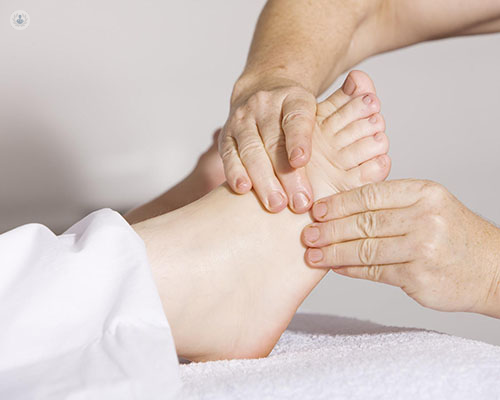An expert’s guide to plantar fasciitis
Escrito por:Plantar fasciitis is common condition that can lead to debilitating pain if left untreated. In this article, plantar fasciitis specialist Mr Bal Dhinsa gives his expert guide to the condition, including the causes, symptoms and possible treatments.
What is plantar fasciitis and how is it caused?
One of the most common causes of pain in the heel is plantar fasciitis. Plantar fasciitis occurs when the plantar fascia is inflamed. The plantar fascia is a thin sheet of tissue stretching from the heel to the toes, that forms the arch of the foot. It usually becomes inflamed when it is either overused or overstretched. Sometimes it can appear after a change in foot wear or after certain activities.
What are the symptoms?
The main symptom of plantar fasciitis is a shooting or stabbing pain under the heel and foot. The pain usually starts when you weight-bear. As you do more weight-bearing, the planta fascia stretches, and the pain can subside. However, if you continue to weight-bear, the plantar fascia can become inflamed again due to overuse.
What precautions should people with plantar fasciitis take before seeing a doctor?
In the majority of cases, plantar fasciitis can be adequately treated with a combination of stretching exercises, analgesics and non-steroidal anti-inflammatory medication. Plantar Fascia Specific Stretching exercises are usually employed to treat the condition, and can sometimes be combined with calf stretches. In order for this to be successful, the patient must comply with the regime.
In certain cases, a doctor will recommend that night splints are used to ensure that the plantar fascia remains stretched throughout the night. However, this can be a very uncomfortable treatment, as it stops the plantar fascia from returning to its normal resting position, which can be very painful in the morning.

What is the course of treatment for plantar fasciitis?
If the stretch routines and other lighter treatments lead to little or no improvement, a combination of stretching and extracorporeal shock wave therapy is advised. Shockwave therapy consists of the inflamed area of the foot being targeted with high frequency shockwave impulses. Shockwave therapy helps to breakdown scarring that comes with the inflammation, which makes the stretching routines much more effective.
If this still does not provide relief, a doctor may recommend needling of the fascia along with injections of corticosteroid. Needling of the plantar fascia can be quite painful, so this procedure is usually performed in an operating theatre while the patient is under sedation. A hypodermic needle is used to scratch scar tissue off the plantar fascia. In order to reduce further inflammation, corticosteroids are then injected. It is essential that the patient continues their stretching routine after this procedure, or else the problems will return.
When is operative management necessary?
In my experience, operating on a patient to relieve plantar fasciitis has unpredictable results. However, if non-surgical forms of treatment are not having the desired outcome, surgery may be appropriate.
If a painful plantar fascia is the only problem the patient has, the surgery will involve a simple incision on the back of the heel. This releases the plantar fascia, and often also releases a trapped nerve that may be causing pain.
If the calf muscles are also tight, and stretching does not alleviate it, surgery to loosen them may be also be suggested by your doctor.

What is the rehabilitation period like?
If you do opt for surgery to treat plantar fasciitis, your foot will have heavy bandaging afterwards. A walking boot and crutches will have to be used to support your foot. It is also essential that you keep the foot elevated as much as you can in the weeks following the surgery. After two weeks, the boot is removed and the patient will begin physiotherapy.
Are there any possible complications associated the surgery?
There are some potential complications associated with this surgery, as there is with any surgery. Before the surgery occurs, your doctor can explain these risks to you. Possible complications include stiffness, nerve injury, infection, swelling and irritation.
Plantar spur removal is usually not recommended by doctors, as evidence suggests that the spur does not cause symptoms of plantar fasciitis, thus removal would not be beneficial to most patients.
Mr Dhinsa is one of the UK's leading consultant orthopaedic surgeons, with more than 15 years of experience. If you are concerned about plantar fasciitis or any other orthopaedic condition, you can make an appointment with Mr Dhinsa via his Top Doctors profile.


